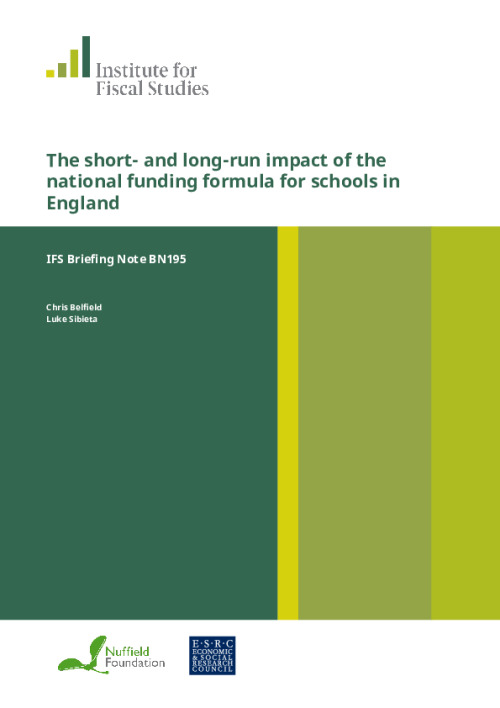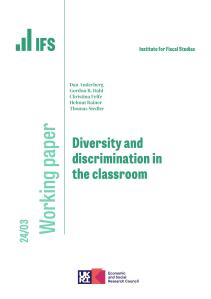The government is embarking on the single largest reform of the school funding system in England for the last 25 years. Currently, the level of funding a school receives is determined by a local-authority-specific funding formula and the amount each local authority receives from central government. The proposed reform, due to be introduced from financial year 2018–19, will replace the 152 different local authority funding formulae with one single National Funding Formula (NFF). When fully in place, this would ensure similar schools in different parts of the country receive a similar amount of funding. While this has been the ambition of successive governments, they have consistently shied away from the hard choices such a reform entails. The current government is to be applauded for making specific proposals, setting out the reasons for the choices it has made and publishing a large amount of data alongside these proposals to enable effective scrutiny.
This briefing note provides impartial explanation and analysis of the proposed reforms. We start by briefly presenting the case for reform, before setting out what the government has proposed, including transition arrangements. We then analyse the likely effects of these reforms on different schools and areas in the short run up to 2019–20. Such analysis confirms and complements the detailed report recently released by the Education Policy Institute. We then extend this to analyse what is likely to happen after 2019–20. Only about 60% of schools will be on the main funding formula by this date and the government has provided worryingly little clarity on how quickly remaining schools will be moved onto the new formula. We analyse a number of hypothetical paths for the transition after 2019–20.
Key findings
Largest reform to school funding in over 25 years |
| Government proposals for a National Funding Formula (NFF) for schools in England starting in 2018–19 would replace the 152 different local authority funding formulae with one single formula. The government is to be applauded for making specific proposals and setting out the reasons for the choices it has made. |
Reform comes at a time of heavy strain on school budgets |
| School funding per pupil has been frozen in cash terms between 2015–16 and 2019–20, resulting in a real-terms cut of 6.5%. This would be the largest cut in school spending per pupil over a four-year period since at least the early 1980s and would return school spending per pupil to about the same real-terms level as it was in 2010–11. Any losses schools face as a result of the NFF come on top of this cut. |
Wide variation in funding per pupil mostly preserved |
| Wide variation in funding across schools that currently exists is mostly the result of deliberate choices to target funding towards disadvantaged schools and high-cost areas. The proposed NFF would largely preserve this variation. The intention of the reform is to ensure similar schools are funded in a similar way, rather than to reduce all disparities in funding across schools. |
Inevitably, there are winners and losers |
| Grants to local authorities are currently based on information that is nearly 15 years out of date. Local authorities also make different choices in their current funding formulae. Harmonising these formulae and ensuring allocations to different areas are based on up-to-date information was always going to create winners and losers. |
Some redistribution across different types of schools and areas |
| Funding is diverted from schools with very high levels of deprivation to those with average levels. There is also a shift in funding towards small primary schools and large secondary schools. Schools in inner London are among the biggest losers, with average cuts of around 2.5% in cash-terms per-pupil funding between 2017–18 and 2019–20. |
Pupil Premium not included in the funding formula |
| This is despite the formula including a specific amount for pupils who have been eligible for free school meals in the past six years – the same factor Pupil Premium is based on. The government should rationalise sources of funding by adding the Pupil Premium to the NFF and hold schools to account for all additional funding they receive for pupils from disadvantaged backgrounds. |
Large number of schools won’t be on the main funding formula by 2019–20 |
| Proposed protections would prevent any school from losing more than 3% of funding per pupil in cash terms between 2017–18 and 2019–20. Since many schools’ budgets are a long way from those implied by the formula, only 60% of schools will be on the main formula in 2019–20. Around 5% of schools would have budgets over 7% higher than that implied by the formula in 2019–20. |
Government has not said how it will move all schools to main formula after 2019–20 |
| We model three scenarios for transiting all schools to the new formula, all incorporating a maximum annual cash-terms loss of 1.5%. If overall school spending per pupil is frozen in cash terms after 2019–20, all schools get to the main formula by 2029–30. If there is a real-terms freeze to overall spending, all schools get there by 2024–25; and if there is 2% real-terms growth, all schools get there by 2023–24. |










